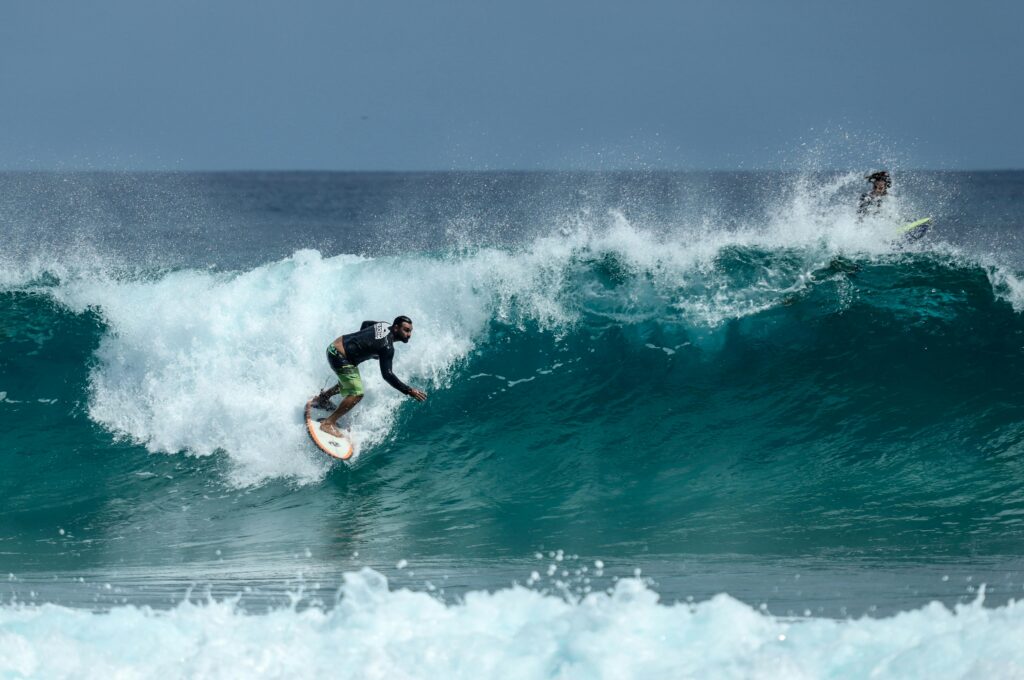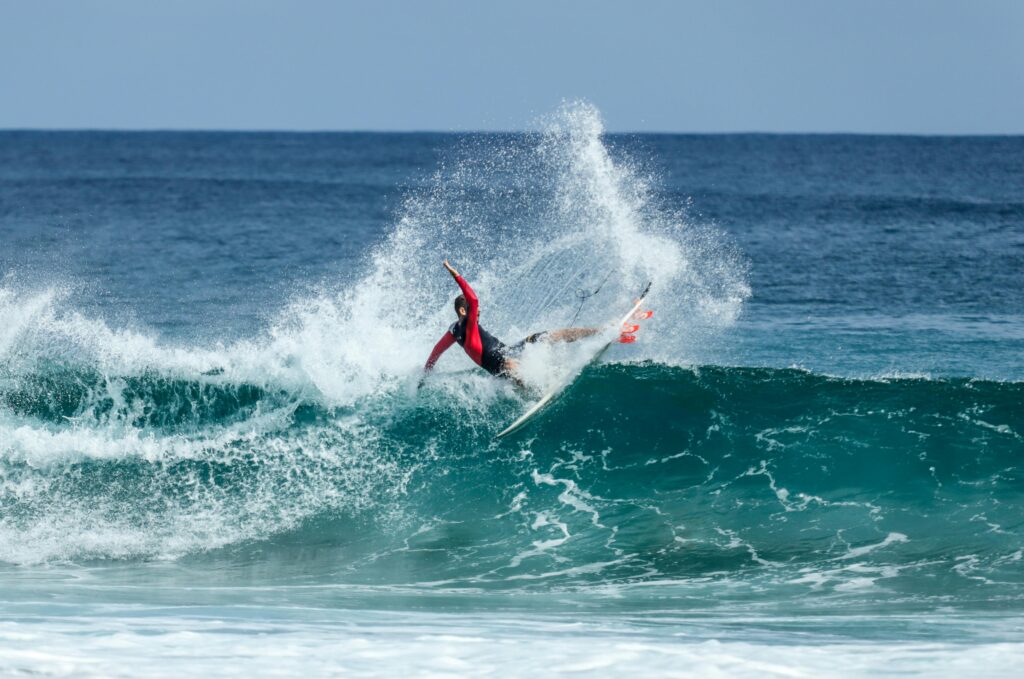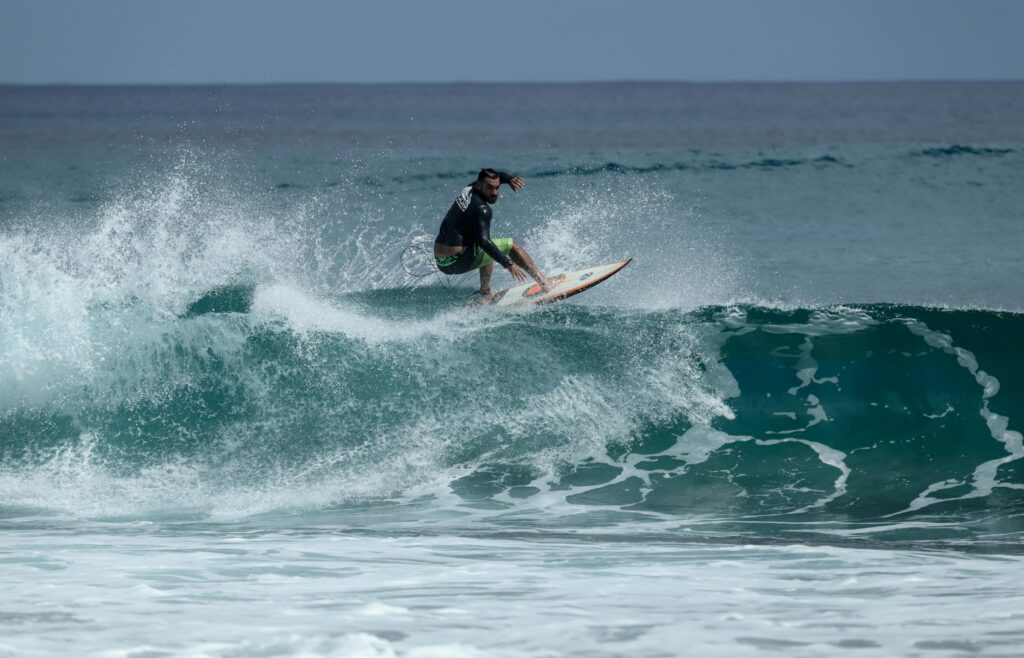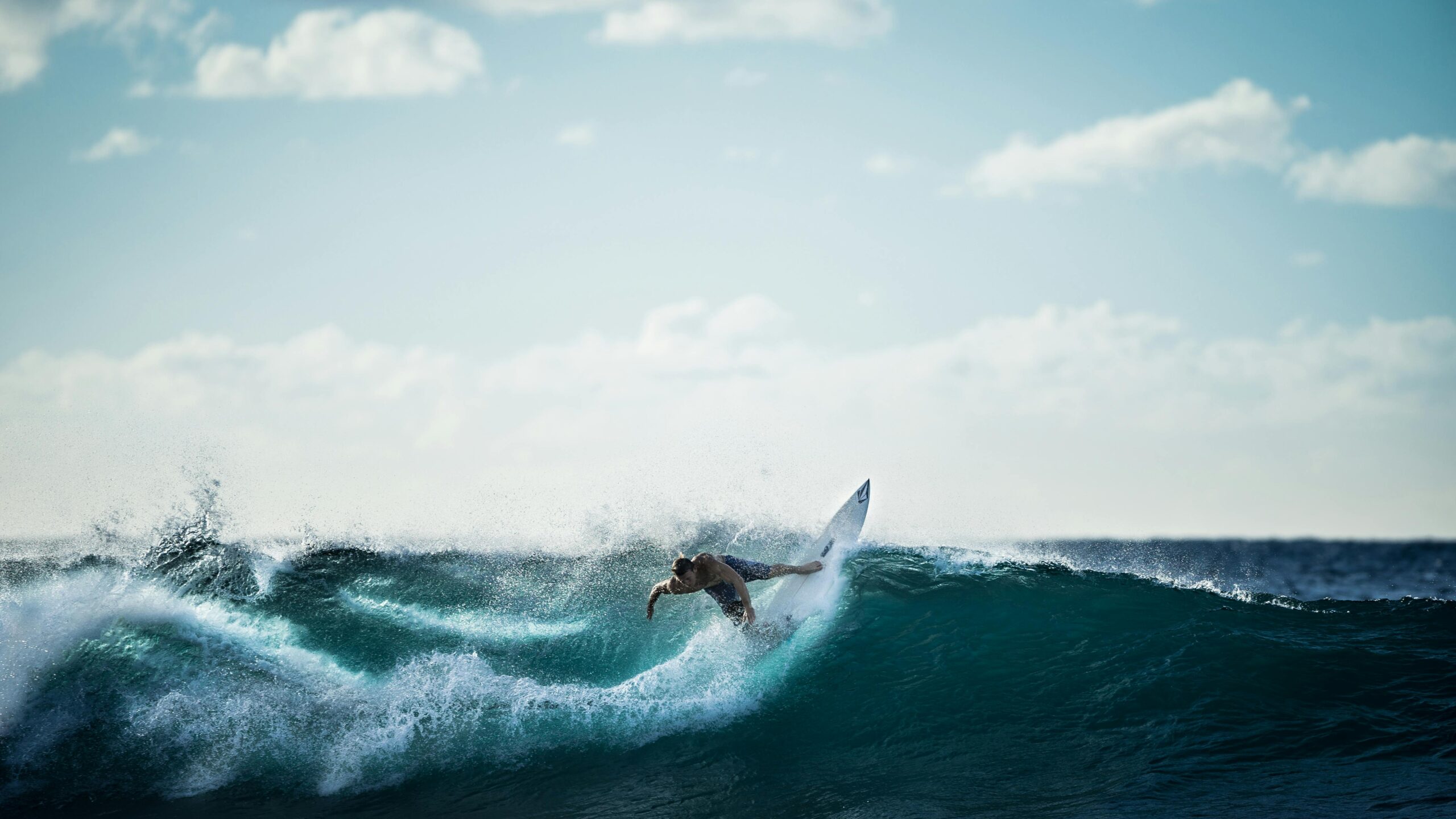I could feel the board lifting beneath me, just for an instant, as the momentum of the wave began to accelerate. Your body, its nuanced reflexes learned from repetition, take over in that moment, propelling you to a crouched position as a sense of free fall begins to envelop you.

The board begins to slide along beneath your feet, as you grapple with the innate desire for balance while the white water begins to boil all around you. It all happens so fast, as your feet find their footing, the sense of falling gives way to gliding, and for a brief episode in the span of time – you are pushed by the eternity of the sea in a joy ride that could only be described as thoroughly harmonious with the universe.
The joy of surfing is its simplicity, only after you’ve endured the frustration of failing to figure it out most of your life. There are so many factors which have to go “right” in order for you to catch, balance upon, and ride that wave…before you could ever know the pleasure of a few brief moments of seaward serenity.
Marketing is no different, in that you must first invest the time, patience, failures, and fortitude to be successful. Though my opportunities to go surfing are more limited than I would like, as I think about my recent time upon the waves, I can’t help but ponder the analogous relationship between the principles of surfing and the tenants of successful marketing strategies.
Surfing Principles Applied to Understanding Audiences

The modern techniques of digital marketing could be considered the art of riding waves of consumer behavior, trends, and interests. Just as an aspiring surfer must master the principles of balance, rhythm, technique, and timing to navigate the dynamic formation of waves, a marketer must understand and anticipate the movements of their audiences in order to achieve success. I think it’s high time to explore the compelling parallels between the principles of surfing and the principles of marketing, particularly in the context of how understanding audiences, their behavior, and interests – is akin to reading waves, training your mind/body, and adapting to the perpetually shifting essence of the ocean.
The Principles of Surfing
Surfing is a sport, or more introspectively, a commitment, that demands a deep connection between the surfer and the elements of the sea. To enjoy the pleasure of gliding upon the apex of a wave successfully, a surfer must master four key principles: balance, rhythm, technique, and timing.
- Balance is essential for maintaining stability on the board, allowing a surfer to respond to the changing contours of the wave, its momentum, angle, and incline. The body must hold a specific position depending on the movement of the sea, which requires subtle shifts in body weight and dynamic adjustments to one’s center of balance.
- Rhythm is effectively the surfer’s ability to flow with the wave’s energy, matching their movements to the wave’s pace and progression. It can take years to truly understand the “rhythm” of the sea, particularly when it is roaring all around you.
- Technique refers to the nuanced skills and maneuvers which must be successfully applied to navigate a wave, or avoid it – such as paddling, popping up, and turning.
- Timing, beyond comparison, is crucial for catching a wave at just the right moment in its progression, in order to afford an opportunity to apply all the other principles seamlessly and with precision.
The Principles of Marketing in Their Basic Form

In the irreverently frustrating and dynamic industry of marketing, understanding audiences is the foundation upon which all effective strategies are defined and built. Just as a surfer must scrupulously read the waves and anticipate their movements, a marketer must intuitively interpret the behavior, preferences, and interests of distinctive audiences which constantly evolve.
Understanding the emotional, progressional, and nuanced motivations of audience intentions allows marketers to create meticulously targeted campaigns which deliver messages that resonate deeply with consumers. Like surfing, marketing requires a balance between creativity and real time data-driven insights – a rhythm that aligns with the audience’s pace, a technique that leverages the right channels and tactics, and impeccable timing to capitalize on opportunities.
Reading the Waves of Consumer Behavior Like Only Keanu Could

Just as a surfer studies the ocean’s conditions, such as wind direction, swell size, and tide, to predict the formation and movement of waves, a marketer must analyze consumer behavior to anticipate trends and preferences. If we step back and consider the extraordinarily complex online shopping behaviors that consumers demonstrate across a myriad of devices and channels – understanding how these interactions in an omnichannel environment take form is fundamental to architecting strategies which engage people at the “correct” stage of their buying process.
Marketers can use a variety of tools to track website navigation patterns, user engagement with various content assets, and even conversion or abandonment rates, much like how a surfer uses sophisticated weather reports and surf forecasts to gauge the conditions of the ocean. The least common denominator between surfing and marketing, in the context of “reading the waves” – is a deep understanding of the environment. The more time invested understanding how an ecosystem works, the more likely it is you can anticipate what’s going to happen.
Catching the Perfect Wave of Personalization

Personalization has become a key aspect of modern marketing, as consumers increasingly expect tailored experiences which cater to their interests, preferences, and distinctive purchasing behaviors. In surfing, catching the perfect wave requires a combination of skill, experience, and instinct. Similarly, delivering personalized marketing messages demands a deep understanding of the individual consumer’s preferences and behavior. By leveraging data from various touchpoints, such as browsing history, purchase records, and social media interactions, marketers can create targeted recommendations and offers that resonate with each customer.
Tools like Klaviyo and Criteo afford marketers an opportunity to do just that – connect with prospects and customers in a meaningful way based on their interests and preferences. Just as a surfer must choose the right wave and position themselves strategically to maximize their takeoff and ride – marketers must select the most impactful resources to engage audiences effectively (on their own terms) while curating compelling messages that engage and convert their audience.
Navigating the Currents of Social Proof

In the relentless churn of tides which define the essential flow of our oceans, currents play a significant role in sculpting waves and influencing a surfer’s route to a break. In the context of eCommerce, social proof acts as a powerful current that can sway consumer behavior and turn the tide in one retailers favor almost instantly. Social proof has become an indelible phenomenon where people look to the actions and opinions of complete strangers to guide their own decisions. In marketing, social proof can take many forms, such as customer reviews, testimonials, and social media mentions. Just as a surfer must navigate tricky rip currents to reach the best waves, marketers must leverage social proof to build trust and credibility with their audience. By showcasing positive endorsements, unsolicited testimonials, user-generated content, and influencer approval, marketers can convey a sense of validation – thereby encouraging consumers to make purchase decisions definitively. This is not dissimilar to how a novice surfer might follow the lead of experienced riders to find where to sit just outside of a break.
The Inevitable Importance of Adaptability

In both surfing and marketing, adaptability is a crucial skill for success. The ocean is a dynamic environment, with changing winds, tides, and swells that can alter the shape and power of the waves in an instant. This is hardly different from the marketing landscape, which is constantly evolving as new technologies, platforms, and consumer preferences emerge at a pace that hardly any agency or firm can manage. Just as a surfer must be prepared to adjust their timing and technique based on changing ocean conditions, a marketer must remain agile and responsive to the shifting tides of their industry.
This adaptability requires a mindset of continuous learning and experimentation. Surfers spend countless hours, arguably a lifetime, studying the ocean, practicing techniques, and refining the skills needed to improve performance. Marketers, too, must invest in ongoing education while remaining cognizant of the latest trends, tools, and best practices in their field. By embracing a culture of testing and iteration, marketers can identify what works best for their audience and optimize their strategies accordingly.
Perhaps the most important principle of marketing and surfing, adaptability, demands a willingness to take calculated risks. In surfing, pushing beyond one’s comfort zone and attempting new maneuvers can lead to growth, and ultimately mastery. In marketing, taking calculated risks, such as experimenting with new channels, formats, or messaging, can unlock fresh opportunities and catalyze the adoption of innovative techniques. By embracing a spirit of creativity and calculated risk-taking, marketers can stay ahead of the curve while discovering tangible opportunities to meaningfully connect with various audiences.
The Power of Intuition

While the pillars of “data” and “analysis” are essential concepts for both surfers and marketers, intuition remains a vital aspect of adaptable decision-making. Beyond the break of less explored surfing destinations, experienced riders rely on their “gut” or inherent instincts to read waves and make split-second decisions. They develop a sixth sense for the ocean, allowing them to anticipate changes in the swell and adjust their positioning instinctively.
Similarly, in marketing, intuition can be a powerful complement to data-driven insights. Seasoned marketers often have a keen sense of their audience’s needs and preferences, informed by years of experience, making mistakes, and cultivating a deep understanding of human behavior. This intuition allows progressive marketers to spot emerging trends, identify creative opportunities, and to develop compelling messages that inspire, inform, and motivate people to think, feel, or behave a certain way.
It is essential to strike a balance between intuition and data. Just as a surfer must combine their instincts with a careful study of the ocean’s conditions, a marketer must validate their intuitive hunches with reliable data and authentic research. Blending the art of intuition with the science of analytics enables marketers to make informed decisions, and to create campaigns that truly serve a functional purpose.
That Slow Ride In…
The principles of surfing – balance, rhythm, technique, and timing – offer a powerful metaphor for the art and science of marketing. Just as a surfer must understand and anticipate the movements of the waves, a marketer must deeply comprehend what is happening in their audience’s ecosystem. A marketer must intuitively understand their audience’s interests and preferences, just as a surfer must intimately understand the tides.
The importance of adaptability and the power of intuition are lessons that transcend both surfing and marketing. In a world of constant change, roiled by uncertainty, the ability to adapt – to take calculated risks – to trust your instincts – can be the difference between wiping out and catching the perfect ride across the reef.
Marketers often sell themselves short – they seldom fully embrace the spirit of the surfer – always learning, always exploring, and always pushing the boundaries of what is possible.
…and at the end of the ride, when the wave falls out beneath you…don’t worry. There will be another one waiting for you just beyond the horizon. That is the allure of the sea, and the inevitability of working in the marketing industry. There’s always tomorrow.
And there will always be another wave.








